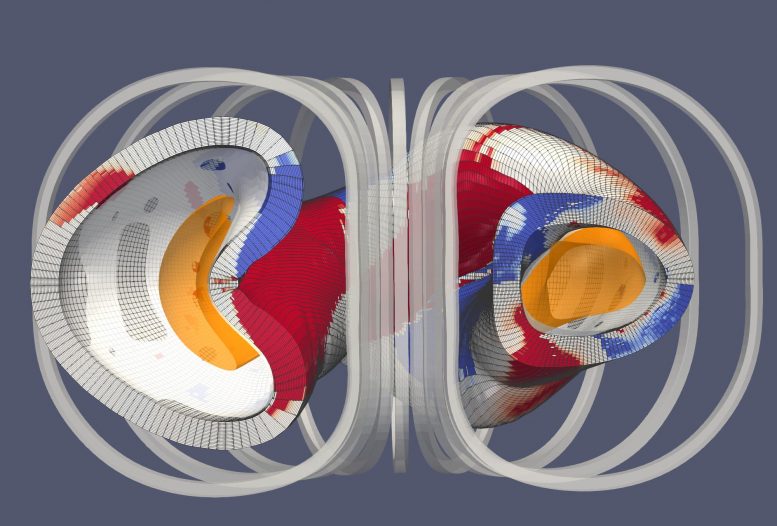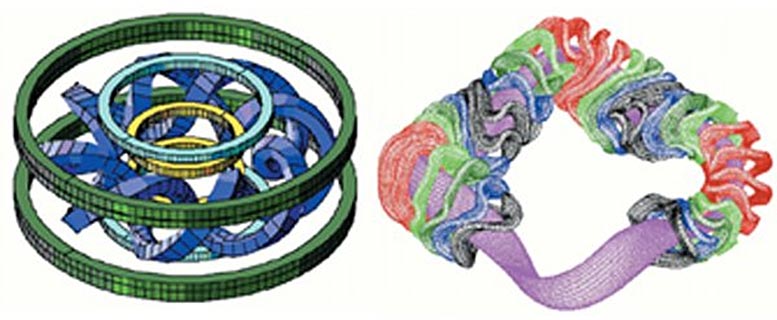
Schematic image of permanent magnet stellarator with plasma in yellow. Red and blue indicate permanent magnets with simplified coils surrounding the vessel. Credit: Coaxing Zhu
Fusion power may be able to provide the world with safe, clean, and renewable power. The stellarator is one of the technologies scientists believe could lead to real-world fusion power. A stellarator is a machine that uses magnetic fields to confine plasma in the shape of a donut, called a torus. These magnetic fields allow scientists to control the plasma particles and create the right conditions for fusion reactions. Stellarators use extremely strong electromagnets to generate twisting magnetic fields that wrap the long way around the donut shape.
Stellarators have several advantages over tokamaks, the other main technology that scientists are exploring for fusion power. Stellarators require less injected power to sustain the plasma, have greater design flexibility, and allow for simplification of some aspects of plasma control. However, these benefits come at the cost of increased complexity, especially for the magnetic field coils.
To advance stellarator design, scientists have turned to high performance computing and state-of-the-art plasma theory. These tools have helped researchers optimize the Helically Symmetric Experiment (HSX) stellarator in Wisconsin and the Wendelstein 7-X stellarator in Germany.

Schematic image of permanent magnet stellarator with plasma in yellow and magnetic surface in blue. Credit: Michael Drevlak
Stellarator Facts
- The stellarator concept was invented by Lyman Spitzer at Princeton University in 1951.
- Much of the early development of stellarators in the 1950s occurred at a laboratory that is now DOE’s Princeton Plasma Physics Laboratory. The work was so difficult that the scientist in charge nicknamed it “Project Matterhorn.”
- Stellarators use external coils to generate a twisting magnetic field to control the plasma instead of inducing electric currents inside the plasma like a tokamak.
- Making stellarator coils is a challenge because it requires manufacturers to construct large bore wire coils with millimeter precision.

Conventional (left) and optimized (right) stellarators both use complex electromagnetic coils to confine plasmas using three-dimensional magnetic fields in the shape of a torus without relying on induced plasma currents to sustain the plasma. Credit: Image courtesy of D. Anderson, University of Wisconsin at Madison
DOE Office of Science & Stellarators
The Department of Energy Office of Science, Fusion Energy Sciences (FES) program is an important supporter of research and development on stellarators. The FES program has two broad goals: expand our understanding of matter at very high temperatures and densities, and build the knowledge needed to develop a fusion energy source. Stellarators may offer an alternative to the tokamak as a future way to produce fusion energy. Stellarator research is also important to help scientists better understand foundational plasma theory. The FES program is particularly looking at how to improve the magnetic fields that control the plasma in stellarators. FES also collaborates on the W7-X facility in Germany to study technologies for producing fusion power and conducting fusion experiments. In the future, FES plans to develop control schemes to maintain stable plasmas in stellarators.
Acknowledgements
Matthew Lanctot (U.S. DOE FES Program Manager)